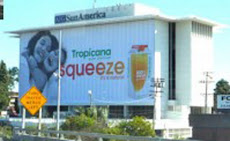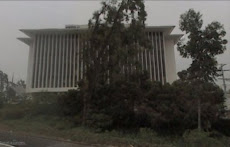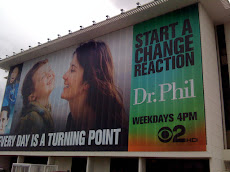Friday, March 27, 2009
Barbara Broide comments on new sign law
Barbara Broide, a staunch anti-billboard activist weighs in on the new sign law just passed by the L.A. City Planning Commission.
An email from Barbara:
Christine Pelisek's article captures fairly well the sense of the City Planning Commission meeting today. The one item that she missed and might have included was that there was the addition of some new language into the ordinance that was worked out since last week's hearing. (The CPC's subcommitte on this ordinance met yesterday.) The most important addition/change was/is the requirement that for every new ditigal or off-site sign allowed in a sign district that there be a mandatory REDUCTION in signage (within an adjacent "sign impact area" (which would be defined as part of a sign district's language). The creation of a sign impact area broadens the area where signs might be reduced from the earlier draft which would have allowed (but not mandate) a reduction inside of the sign district (where there might not be any signs or few in number) or provide for the establishment of a community betterment program to do the removal of grafitti, trash, etc. (which would have been trading one blight for another!).
We pushed very hard to have the ordinance address the need to reduce existing signage. Dennis Hathaway of Coalition to Ban Billboard Blight provided staff with language to do so recommended by the pro bono attorney with sign expertise working with CBBB from Minnesota. The LA ordinance as passed doesn't do enough reduction, but some is better than none. The ordinance did not specify the exact amount of reduction other than it be greater than 1:1 - for every one squre foot of new sign area that goes up, more than one square foot of existing sign area must come down. (We know that a digital sign is worth many times the space of a conventional billboard, so there needs to be a ratio of equivalent values kept in mind when this is applied. Whether there is any hope to expand this provision or seek additional measures when the ordinance goes to PLUM or City Council remains to be seen.
Other recommended amendments to the ordinance:
--limitations on roof signs (I don't know whether this amendment was adopted for certain)
--defining some of the notification and size requirements for Comprehensive Sign Programs. There was an added finding, "The size, illumination, height, projection, location and street orientation of proposed signs within 500 feet of a residentially zoned lot are compatible with residential uses."
--administrative civil penalties: requirement to provide more notice of the public hearings. expanded notification of the public hearing to inlcude property owners and occupants within 500 feet of the illegal sign. {However, note that they did not adopt language requiring notification of the local neighborhood council.}
--right of private action: it is being limited to the owners or occupants of real property within a 500 foot radium of the subject property. (We wanted others to be able to bring action in addition to the neighbors should the city fail to enforce the law.)
--sign districts: in addition to the sign reduction requirement, there will be language that says that only the demolition of existing, lawfully permitted off-site signs count toward the mandatory sign reduction. (This is necessary because in the past, some outdoor advertising companies, when faced with the requirement to remove signage, have taken down illegal unpermitted signs and had them "count" when they never should have been there in the first place.) A new finding was added for sign districts: "The proposed special sign regulations will further the applicable goals, objectives and policies of the urban form and neighborhood design chapter of the Framework Element of the General Plan."
Within 6 nonths of hte date of the new ordinance's adoption, staff are being instructed to adopt guidelines to review the proposed sign districts.
Only those sign districts (2) that had been heard before the CPC and approved as of today, shall be subject to the existing code (ie--grandfathered in). All other proposed sign districts will be subject to the new ordinance. (This is a significant win for our side.)
The issue as to whether or not to include a provision allowing the City to revoke the business licenses of sign companies that repeatedly violate the sign regulations or do not pay their assessed civil penalties has been referred to the City Attorney for advice.
Within one year after the ordinance goes into effect, a task force will be convened (representing diverse points of view) to review the impact of the ordinance, propsed necesasry amendments, study the feasibility of regulating digital on-site signs (now banned), and to study the feasibility of requiring billboard registration with Building and Safety (which I believe is already a power granted to B & S as part of the inspection program).
Mike Woo introduced additional language that is being added into the purpose of the ordinance (rather than as additional findings which is what Commissioner Woo had sought). He also requested language that would specify that the ordinance applies to the digital signs allowed by the billboard settlements so that new digital signs would/could not be erected outside of sign districts (that conversions would only be allowed in sign districts). He asked for language referencing the possibility that communities, within their community plans could use special use districts to create SIGN FREE DISTRICTS (off-site sign free), sending a very clear message that this is very much a possibility and tool that can be used for this purpose. Those sitting near me (and I) did not think that Commissioner Woo's amendments had been adopted but others with whom we spoke afterwards thought that they had.
Commissioners Woo, and Kezios have been the voice for good legislation at the hearings since this issue first appeared on the agenda of the CPC, under the leadership of Chairperson Usher. I have no doubt that if Ms. Usher were still the Chair of the CPC that the final product would appear significantly different on a number of important points. At the recent CPC meetings, Commissioner Cindy Montanez joined Commissioners Woo and Kezios asking very directed questions to address shortcomings in the ordinance. She joined Woo and Kezios in voting against the final product today.
One result of today's meeting may be that there be some challenge related to Brown Act compliance because the CPC did not allow testimony to be taken today at the hearing. The Chair indicated that since this was the FIFTH hearing on the topic (unprecidented) and since they had already heard a great deal from those interested, that they would not be allowing testimony. However, they introduced changes in the ordinance --changes none of us had seen or heard in advance AND copies of the language were not distributed until after the vote when the CPC had moved on to another item. Some believe this to be a breach of the Brown Act. I suspect there will be follow up on this.
I would expect that the LA Times will have a story on this in Friday's paper as one of their reporters was there today. (There was a not so well appreciated article on signage in today's paper by an architecture critic.) Also in the audience were members of a film team that is working on a documentary on signage (internationally) as well as the KCET producer for SoCal Connected who did the earlier three segments on signage and may be doing a fourth one.
Barbara
I suggest that individuals write to Commissioner Mike Woo, Father /Commissioner Spencer Kezios, and Commissioner Cindy Montanez to thank them for their leadership on this issue and for their efforts on behalf of the City. If you write to them in care of the Commission's Executive Assistant James Williams, they will get your notes: james.k.williams@lacity.org. Ask him to forward your message to each of the three Commissioners.
An email from Barbara:
Christine Pelisek's article captures fairly well the sense of the City Planning Commission meeting today. The one item that she missed and might have included was that there was the addition of some new language into the ordinance that was worked out since last week's hearing. (The CPC's subcommitte on this ordinance met yesterday.) The most important addition/change was/is the requirement that for every new ditigal or off-site sign allowed in a sign district that there be a mandatory REDUCTION in signage (within an adjacent "sign impact area" (which would be defined as part of a sign district's language). The creation of a sign impact area broadens the area where signs might be reduced from the earlier draft which would have allowed (but not mandate) a reduction inside of the sign district (where there might not be any signs or few in number) or provide for the establishment of a community betterment program to do the removal of grafitti, trash, etc. (which would have been trading one blight for another!).
We pushed very hard to have the ordinance address the need to reduce existing signage. Dennis Hathaway of Coalition to Ban Billboard Blight provided staff with language to do so recommended by the pro bono attorney with sign expertise working with CBBB from Minnesota. The LA ordinance as passed doesn't do enough reduction, but some is better than none. The ordinance did not specify the exact amount of reduction other than it be greater than 1:1 - for every one squre foot of new sign area that goes up, more than one square foot of existing sign area must come down. (We know that a digital sign is worth many times the space of a conventional billboard, so there needs to be a ratio of equivalent values kept in mind when this is applied. Whether there is any hope to expand this provision or seek additional measures when the ordinance goes to PLUM or City Council remains to be seen.
Other recommended amendments to the ordinance:
--limitations on roof signs (I don't know whether this amendment was adopted for certain)
--defining some of the notification and size requirements for Comprehensive Sign Programs. There was an added finding, "The size, illumination, height, projection, location and street orientation of proposed signs within 500 feet of a residentially zoned lot are compatible with residential uses."
--administrative civil penalties: requirement to provide more notice of the public hearings. expanded notification of the public hearing to inlcude property owners and occupants within 500 feet of the illegal sign. {However, note that they did not adopt language requiring notification of the local neighborhood council.}
--right of private action: it is being limited to the owners or occupants of real property within a 500 foot radium of the subject property. (We wanted others to be able to bring action in addition to the neighbors should the city fail to enforce the law.)
--sign districts: in addition to the sign reduction requirement, there will be language that says that only the demolition of existing, lawfully permitted off-site signs count toward the mandatory sign reduction. (This is necessary because in the past, some outdoor advertising companies, when faced with the requirement to remove signage, have taken down illegal unpermitted signs and had them "count" when they never should have been there in the first place.) A new finding was added for sign districts: "The proposed special sign regulations will further the applicable goals, objectives and policies of the urban form and neighborhood design chapter of the Framework Element of the General Plan."
Within 6 nonths of hte date of the new ordinance's adoption, staff are being instructed to adopt guidelines to review the proposed sign districts.
Only those sign districts (2) that had been heard before the CPC and approved as of today, shall be subject to the existing code (ie--grandfathered in). All other proposed sign districts will be subject to the new ordinance. (This is a significant win for our side.)
The issue as to whether or not to include a provision allowing the City to revoke the business licenses of sign companies that repeatedly violate the sign regulations or do not pay their assessed civil penalties has been referred to the City Attorney for advice.
Within one year after the ordinance goes into effect, a task force will be convened (representing diverse points of view) to review the impact of the ordinance, propsed necesasry amendments, study the feasibility of regulating digital on-site signs (now banned), and to study the feasibility of requiring billboard registration with Building and Safety (which I believe is already a power granted to B & S as part of the inspection program).
Mike Woo introduced additional language that is being added into the purpose of the ordinance (rather than as additional findings which is what Commissioner Woo had sought). He also requested language that would specify that the ordinance applies to the digital signs allowed by the billboard settlements so that new digital signs would/could not be erected outside of sign districts (that conversions would only be allowed in sign districts). He asked for language referencing the possibility that communities, within their community plans could use special use districts to create SIGN FREE DISTRICTS (off-site sign free), sending a very clear message that this is very much a possibility and tool that can be used for this purpose. Those sitting near me (and I) did not think that Commissioner Woo's amendments had been adopted but others with whom we spoke afterwards thought that they had.
Commissioners Woo, and Kezios have been the voice for good legislation at the hearings since this issue first appeared on the agenda of the CPC, under the leadership of Chairperson Usher. I have no doubt that if Ms. Usher were still the Chair of the CPC that the final product would appear significantly different on a number of important points. At the recent CPC meetings, Commissioner Cindy Montanez joined Commissioners Woo and Kezios asking very directed questions to address shortcomings in the ordinance. She joined Woo and Kezios in voting against the final product today.
One result of today's meeting may be that there be some challenge related to Brown Act compliance because the CPC did not allow testimony to be taken today at the hearing. The Chair indicated that since this was the FIFTH hearing on the topic (unprecidented) and since they had already heard a great deal from those interested, that they would not be allowing testimony. However, they introduced changes in the ordinance --changes none of us had seen or heard in advance AND copies of the language were not distributed until after the vote when the CPC had moved on to another item. Some believe this to be a breach of the Brown Act. I suspect there will be follow up on this.
I would expect that the LA Times will have a story on this in Friday's paper as one of their reporters was there today. (There was a not so well appreciated article on signage in today's paper by an architecture critic.) Also in the audience were members of a film team that is working on a documentary on signage (internationally) as well as the KCET producer for SoCal Connected who did the earlier three segments on signage and may be doing a fourth one.
Barbara
I suggest that individuals write to Commissioner Mike Woo, Father /Commissioner Spencer Kezios, and Commissioner Cindy Montanez to thank them for their leadership on this issue and for their efforts on behalf of the City. If you write to them in care of the Commission's Executive Assistant James Williams, they will get your notes: james.k.williams@lacity.org. Ask him to forward your message to each of the three Commissioners.
Subscribe to:
Post Comments (Atom)







No comments:
Post a Comment